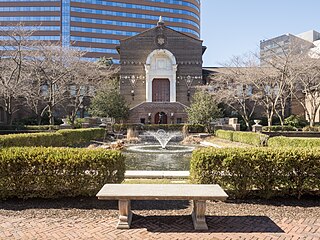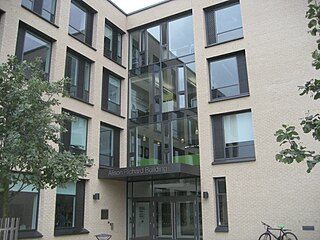
Anthropology is the scientific study of humanity, concerned with human behavior, human biology, cultures, societies, and linguistics, in both the present and past, including archaic humans. Social anthropology studies patterns of behavior, while cultural anthropology studies cultural meaning, including norms and values. The term sociocultural anthropology is commonly used today. Linguistic anthropology studies how language influences social life. Biological or physical anthropology studies the biological development of humans.

The Museum of Anthropology at the University of British Columbia (UBC) campus in Vancouver, British Columbia, Canada displays world arts and cultures, in particular works by First Nations of the Pacific Northwest. As well as being a major tourist destination, MOA is a research and teaching museum, where UBC courses in art, anthropology, archaeology, conservation, and museum studies are given. MOA houses close to 50,000 ethnographic objects, as well as 535,000 archaeological objects in its building alone.

Penn Museum, formerly known as The University of Pennsylvania Museum of Archaeology and Anthropology, is an archaeology and anthropology museum at the University of Pennsylvania. It is located on Penn's campus in the University City neighborhood of Philadelphia, at the intersection of 33rd and South Streets. It also is close enough for Drexel University students to walk or take SEPTA transportation services. Housing over 1.3 million artifacts, the museum features one of the most comprehensive collections of Middle and Near-Eastern art in the world.

The French School of the Far East, abbreviated EFEO, is an associated college of PSL University dedicated to the study of Asian societies. It was founded in 1900 with headquarters in Hanoi in what was then French Indochina. After the independence of Vietnam, its headquarters were transferred to Phnom Penh in 1957, and subsequently to Paris in 1975. Its main fields of research are archaeology, philology and the study of modern Asian societies. Since 1907, the EFEO has been in charge of conservation work at the archeological site of Angkor.
Osteology is the scientific study of bones, practised by osteologists. A subdiscipline of anatomy, anthropology, and paleontology, osteology is the detailed study of the structure of bones, skeletal elements, teeth, microbone morphology, function, disease, pathology, the process of ossification from cartilaginous molds, and the resistance and hardness of bones (biophysics).
Xenoarchaeology, a branch of xenology dealing with extraterrestrial cultures, is a hypothetical form of archaeology that exists mainly in works of science fiction. The field is concerned with the study of the material remains to reconstruct and interpret past life-ways of alien civilizations. Xenoarchaeology is not currently practiced by mainstream archaeologists due to the current lack of any material for the discipline to study.
Heritage tourism is a form of tourism that revolves around a region's tangible and intangible cultural heritage. This can involve people, objects, and places associated with the past. Cultural Heritage tourism focuses on the human element of these sites.
Christopher Ralph Chippindale, FSA is a British archaeologist. He worked at the Museum of Archaeology and Anthropology from 1988 to his retirement in 2013, and was additionally Reader in Archaeology at the University of Cambridge from 2001 to 2013.

Jane Ellen Buikstra is an American anthropologist and bioarchaeologist. Her 1977 article on the biological dimensions of archaeology coined and defined the field of bioarchaeology in the US as the application of biological anthropological methods to the study of archaeological problems. Throughout her career, she has authored over 20 books and 150 articles. Buikstra's current research focuses on an analysis of the Phaleron cemetery near Athens, Greece.

Tom Dalton Dillehay is an American anthropologist currently serving as the Rebecca Webb Wilson University Distinguished Professor of Anthropology, Religion, and Culture, as well as a Professor of Anthropology at Vanderbilt University. He has previously held teaching positions at the Universidad Austral de Chile and the University of Kentucky. Dillehay received his advanced degrees in anthropology from the University of Texas at Austin. He established anthropology departments at the Pontifical Catholic University of Chile in Temuco and at Austral University of Chile in Valdivia.

George Robert Fischer was an American underwater archaeologist, considered the founding father of the field in the National Park Service. A native Californian, he did undergraduate and graduate work at Stanford University, and began his career with the National Park Service in 1959, which included assignments in six parks, the Washington, D.C. Office, and the Southeast Archaeological Center from which he retired in 1988. He began teaching courses in underwater archaeology at Florida State University in 1974 and co-instructed inter-disciplinary courses in scientific diving techniques. After retirement from the NPS his FSU activities were expanded and his assistance helped shape the university's program in underwater archaeology.

The Museum of Archaeology and Anthropology, also known as MAA, at the University of Cambridge houses the university's collections of local antiquities, together with archaeological and ethnographic artefacts from around the world. The museum is located on the university's Downing Site, on the corner of Downing Street and Tennis Court Road. In 2013 it reopened following a major refurbishment of the exhibition galleries, with a new public entrance directly on to Downing Street.
Robert J. Sharer was an American archaeologist, academic and Mayanist researcher. He was known for his archaeological investigations at a number of pre-Columbian Mesoamerican sites conducted over a career spanning four decades, and for his archaeological reports, theorizing, and writings in his field of specialty, the ancient Maya civilization. Sharer was a lecturer and professor at the University of Pennsylvania's Department of Anthropology for more than 30 years, and as of 2008, occupied the endowed chair of Sally and Alvin V. Shoemaker Professor in Anthropology, an appointment which he held beginning in 1995. He also had an extensive association with Penn's University Museum of archaeology and anthropology, where from 1987 to 2009 he was the curator-in-charge of the museum's American collection and research section. He died on September 20, 2012.

The Faculty of Human, Social, and Political Science at the University of Cambridge was created in 2011 out of a merger of the Faculty of Archaeology and Anthropology and the Faculty of Politics, Psychology, Sociology and International Studies. According to the Cambridge HSPS website: graduates pursue careers in "research, the Civil Service, journalism, management consultancy, museums, conservation and heritage management, national and international NGOs and development agencies, the Law, teaching, publishing, health management, and public relations."
Gary O. Rollefson is a Near Eastern prehistoric archaeologist.
Eleanor Kathleen Gough Aberle was a British anthropologist and feminist who was known for her work in South Asia and South-East Asia. As a part of her doctorate work, she did field research in Malabar district from 1947 to 1949. She did further research in Tanjore district from 1950 to 1953 and again in 1976, and in Vietnam in 1976 and 1982. In addition, some of her work included campaigning for: nuclear disarmament, the civil rights movement, women's rights, the third world and the end of the Vietnam War. She was known for her Marxist leanings and was on an FBI watchlist.
Peter Stafford Bellwood is Emeritus Professor of Archaeology in the School of Archaeology and Anthropology at the Australian National University (ANU) in Canberra. He is well known for his Out of Taiwan model regarding the spread of Austronesian languages.
Matthew Spriggs is an emeritus professor of archaeology at the School of Archaeology and Anthropology of the Australian National University (ANU) in Canberra. He was educated at St John's College, Cambridge. He has made major contributions in the archaeology of Southeast Asia and the Pacific and is particularly well known for his work investigating the Lapita culture cemetery at Teouma in Vanuatu.

St. Philip Neri Parish Historic District is a historic Roman Catholic church complex and national historic district located at Indianapolis, Indiana. The district encompasses five contributing buildings: the church, rectory, former convent and school, school, and boiler house / garage. The church was built in 1909, and is a Romanesque Revival brick church with limestone trim. It features two- and three-story crenellated corner towers, a rose window with flanking round arched windows, and Doric order columns flanking the main entrance.
Ngườm is an archaeological site in Thái Nguyên Province, northern Vietnam. It is a rock shelter in a limestone cliff near the Thần Sa River that was excavated in 1981 by archaeologists from the Vietnam Institute of Archaeology. Flaked stone artefacts have been found in deposits containing shells with radiocarbon ages of 23,000 years ago. The site is important because of its unusually high proportion of retouched flakes in the stone artefact assemblage, relative to other sites in Southeast Asia.










